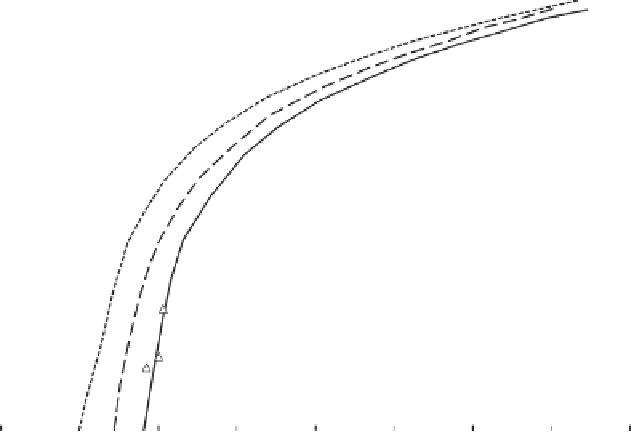Environmental Engineering Reference
In-Depth Information
0.4
Volumetric water content versus suction
Field depth 0 - 0.15 (m)
0.3
Field depth 0.30 - 0.45 (m)
Field depth 0.60 - 0.90 (m)
0.2
0.1
0
0
10
20
30
40
Matric suction (
u
a
-
u
w
), kPa
(a)
10
−
4
10
−
5
10
−
6
Lakeland fine sand
10
−
7
10
−
8
Permeability versus volumetric water content
Field depth 0 - 0.15 (m),
k
s
= 4.1 x 10
-5
(
m
/
s
)
Field depth 0.30 - 0.45 (m),
k
s
= 3.6 x 10
-5
(
m
/
s
)
10
−
9
10
−
10
Field depth 0.60 - 0.90 (m),
k
s
= 4.8 x 10
-5
(
m
/
s
)
10
−
11
0
0.1
0.2
0.3
0.4
Volumetric water content,
(b)
Figure 8.6
Comparisons between calculated and measured coefficients of permeability for Lake-
land fine sand: (a) SWCC; (b) water coefficient for permeability as function of volumetric water
content (after Elzeftawy and Cartwright, 1981).
j
in Eq. 8.10
describes the shape of the permeability function. The
coefficient-of-permeability values
k
w
are adjusted in accor-
dance with the saturated coefficient of permeability
k
s
.The
A
d
term does not need to be computed and is assumed to
be unity when the saturated coefficient of permeability is
independently measured.
The term
j
=
i
(
2
j
2
i)
u
a
−
u
w
−
2
The saturated coefficient of permeability
k
s
in the ex-
+
1
−
10
−
8
(m/s) (Gonzalez
and Adams, 1980). The permeability function
k
w
(θ)
i
is calculated by substituting matric suction values from
the midpoints along the drying curve into Eq. 8.10. The
saturated coefficient of permeability
k
s
was measured in a
laboratory test using the steady-state method (Gonzalez and
Adams, 1980). Similar computations of the permeability
ample shown has a value of 5
.
83
×




































































Search WWH ::

Custom Search